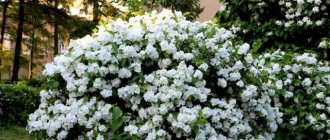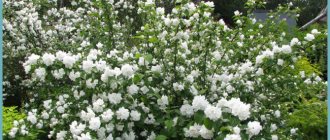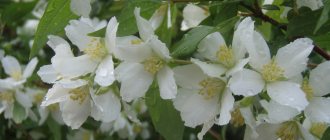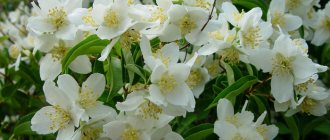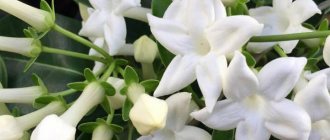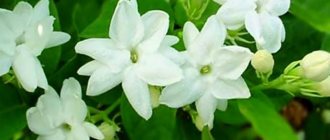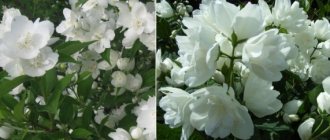Description of appearance
- The leaves are oval-shaped, located opposite each other on the shoots. The lower part of the leaf is usually not much pubescent.
- Inflorescences in the form of a brush can form both in the axils of the upper leaves and on the tops of the shoots.
- The flowers are simple in shape with 4 – 5 petals, large, up to 7 cm in diameter. The color of the flowers is white or with a cream tint.
Flowering mock orange became widespread in Russia back in the 16th-17th centuries. It was grown in the gardens of the king and boyars.
Some species are very winter-hardy and can withstand temperatures down to – 25C. For most varieties, already - 15C is the limit of possibilities, and they can freeze to snow cover. However, this does not harm the bush; it will grow back in the spring.
This is interesting: mock orange trunks are hollow inside. Previously, pipes and smoking pipes were made from them.
Main characteristics
Chubushnik Snowbel belongs to the 5th winter hardiness zone. It survives frosts well down to -28 degrees. At lower temperatures, the buds freeze slightly, but as the shrub develops, it quickly restores its decorative qualities.
Corona jasmine is drought-resistant and also does well in urban environments. Tolerates all types of pruning. Grows well in a variety of soils. Does not like increased moisture or salinity. Mock orange is shade-tolerant, but grows better in sunny places.
Chubushnik Snowbel is resistant to diseases and pests. If not properly cared for, may be susceptible to disease. The most dangerous pest is aphids.
Based on the description of the main characteristics, Snowbelle mock orange can be grown in central Russia with minimal time, unlike true jasmine.
The most famous varieties of garden jasmine
Many varieties and hybrid forms have been bred by foreign and domestic breeders, photo.
Mock orange crown
Chubushnik crown is a tall shrub, up to 3 meters high. The flowers are white, with a strong aroma. Retains the ability to flower up to 30 years of age. Frost-resistant, can withstand temperatures down to – 25C.
Minnesota Snowflake (snowflake)
Minnesota mock orange is frost-resistant. Large double flowers, with narrow petals, look like a wet snowflake. This appearance gave rise to the name of the variety.
Pearl
The “Pearl” variety is the fruit of Russian breeders. It is small in size. The flowers are large, up to 7.5 cm in diameter, with the scent of vanilla.
Blizzard
Terry mock orange, about 1 meter high. This is a highly decorative variety. Numerous flowers are formed at the ends of short branches, so they are arranged quite densely. It seems that the plant was caught in a snow storm.
Lemoine's mock orange is the result of the work of the French company after which it received its name. Popular varieties of this group.
Ermine Robe
Mock orange Ermine mantle is a low-growing shrub, no higher than 80 cm in height. On thin, hanging shoots there are miniature narrow leaves. The flowers are half double with narrow petals and exude the scent of strawberries. One of the longest and most abundantly flowering varieties.
Chubushnik Snowbel (Snow Beauty)
Mock orange Snowbel reaches a height of 3 meters, the shoots are erect with large, 7-centimeter leaves. Double flowers with a strong, pleasant aroma.
This is interesting: the snow beauty has an interesting property - it alternates the formation of double and regular flowers with a frequency of once every 2 years.
History of selection
Crown mock orange Snowbelle is a popular and fairly old variety of garden jasmine. Belongs to the group of Lemoine hybrids and was bred in European greenhouses in the 30s of the 20th century. In appearance and characteristics it has much in common with related varieties, in particular, it is distinguished by high frost resistance, a compact crown and a pleasant rich aroma.
Attention! In 2002, the mock orange Snowbel was awarded the English Royal Horticultural Society award for its decorative properties.
Conditions for keeping mock orange
Garden jasmine is grown only in open ground; it requires a cold winter.
Requirements for the planting site, soil composition
The plant is famous for its unpretentiousness; caring for it is simple:
- The shrub prefers open, bright spaces, where it will grow for up to 25 - 30 years. It can grow in partial shade, but the number of buds and flowering duration will be lower.
- It is not picky about the composition of the soil, with the exception of places with poor drainage. Mock orange does not tolerate stagnant water or waterlogging of the soil.
Any cultivated soil with a universal composition is suitable for it: garden soil, peat, leaf humus, compost, in equal proportions. On loamy soils, additional drainage may be required: pebbles, expanded clay.
Fertilizing, watering
Regular watering is required, avoiding drooping of the leaves. Lack of moisture negatively affects flowering.
Feed the bushes twice a year:
- In early spring, fertilizers containing nitrogen are used: urea, slurry solution.
- At the end of flowering: superphosphate and potassium sulfate, in the dosage recommended by the manufacturer.
How to properly care
The plant requires some care.
Watering
Chubushnik Lemoine - description, planting and care
When planting is complete, you need to water it abundantly. At a time, at least 30 liters. If the weather is rainy, then once every 7 days, and when there is drought, then every other day. Leaves serve as a visual indicator of the degree of soil moisture, which droop sharply if there is not enough moisture.
This is interesting! Loose soil is one of the necessary conditions. Immediately after quenching thirst, it needs to be loosened to a depth of 8 cm, then mulched. This will keep the soil airy and water retained. With diligent mulching, you can only build up layers in the future.
Top dressing
During the first time there is no urgent need for it. This can cause damage until the roots are fully developed. A year later, the mock orange is fed: a whole bucket of prepared nitrogen liquid for all the bushes. Even if the shoots have already been cut off, the “feeding” process continues.
Trimming
Annual shoots of jasmine serve to lay flower buds. As soon as flowering has passed, you should get rid of all branches with dried inflorescences so that all the plant’s forces can be directed to the development of fresh shoots. Before winter, get rid of excess branches to form a neat crown. And, of course, remove all damaged shoots. Thanks to pruning, it is possible to “revive” a fading old bush. With the beginning of early spring, it is enough to cut out as many branches as possible down to the roots, preserving only a few of the strongest ones. Prudently reducing them to about 30 cm.
The dull buds on these stumps will wake up, and young shoots will appear, which in the future will form such an attractive crown.
Pruning a jasmine bush
Mock orange blossom
Mock orange is grown in gardens for its beautiful flowers, which frame the plant like a bridal veil.
The start of flowering varies depending on the variety and lasts about 20 – 25 days.
In some cases, it stops forming buds, there are reasons for this:
- Age of the seedling. Bushes grown from cuttings bloom in 4–5 years. Seedlings from seeds will have to wait 7–8 years for flowering.
- Shadow. With a lack of lighting, the plant produces fewer buds.
- Severe freezing. This is a temporary phenomenon - after the growth of new shoots, flowering will resume.
- Excessive spring pruning.
Application in landscape design
In the garden, mock orange Snowbel is used for several purposes:
- in hedges;
A medium-sized, spreading variety of mock orange forms a beautiful and dense plant fence - in large flower beds;
Snow-white jasmine Snowbell is placed in the center of artistic compositions - in decorating recreation areas.
Mock orange Snowbel decorates the space next to gazebos and benches and emits a pleasant aroma
The crop can be planted near artificial reservoirs if there is good drainage.
Rules for cutting and forming a bush
To maintain a neat appearance and prevent thickening of the bush, the plant requires pruning. It comes in several types:
- Sanitary pruning. Weak, damaged branches, as well as shoots directed into the bush, must be removed. It can be carried out at any time of the year.
- Anti-aging pruning. Old branches older than 10-12 years are cut at the root. This procedure stimulates the formation of new shoots.
- Formative pruning of mock orange is carried out after flowering has ended. Faded shoots and green tops are removed to the level of lignification. Some varieties are shaped like a ball.
The first pruning of young plants is carried out after planting them in open ground. Only 2 - 3 branches are left, the rest are cut out.
Fragrant symbol of the Russian garden
Mock oranges are called jasmine by mistake because of the similarity of the flower shape and aroma with its subtropical namesake, the cultivation of which in our country is possible only in greenhouse culture.
The deciduous shrub of the Hydrangeaceae family came to Russia during the time of the first Romanovs. The fragrant plant quickly went beyond the boyars’ gardens and “scattered” across the vast expanses of the empire. The shrub came to the court and was already considered a very popular garden decoration at the beginning of the 20th century. Mock orange in appearance is a multi-stemmed shrub, with thin, slightly drooping young shoots, growing on average up to 2 m in height. But there are also large-sized ones (4–5 m), forming an incredibly beautiful spreading fountain, and dwarf forms with a compact bush up to 1 m, decorating rock gardens and rockeries. The main advantage of mock orange is the clusters of flowers, which, if properly cared for, cover the bush with a snow-white fragrant cloud and retain this appearance for 20–30 days.
We draw attention to some biological characteristics of the plant, allowing us to understand its physiology and characteristics of the growing season.
- The culture is light-loving, loves open sunny places, protected by buildings or larger trees from the scorching cold northern winds.
- It prefers moisture-absorbing soils (light loam, black soil), but without excessive stagnation of water. In hot areas without watering, the plant takes on a depressed appearance.
- Whenever you plant a seedling, in spring or autumn, mock orange blooms after planting no earlier than in the third year, some species only in the fifth year.
- Generative (flower) buds are laid on shoots of previous years, but not older than 4–5 years of age, so the bush needs regular rejuvenation.
- The shrub belongs to the long-lived category; it can grow in one place for 35–40 years.
Garden jasmine is such a self-sufficient crop that it looks great in a group, parterre planting, or hedge. What to plant next to mock orange? If you want to create a secluded fragrant corner in the garden, plant other beautiful flowering shrubs nearby - lilac, hydrangea, spirea, weigela. Powerful bushes with bare skeletal branches can be “knocked out” with hostas and brunnera. Mock orange bushes look good against the background of a lawn and coniferous trees.
Reproduction of mock orange
False jasmine reproduces easily and has good survival rate.
Cuttings
Propagation by cuttings is carried out in early summer.
Algorithm of actions:
- Green shoots are cut into pieces 8–10 cm long, the leaves are shortened by half.
- In partial shade, prepare a bed with the following soil composition: humus, turf soil, sand in equal proportions.
- Cuttings of cuttings are treated with a growth stimulator, then planted at a slight slope, to a depth of 1 cm.
- The soil is compacted, the cuttings are covered with glass or a plastic bottle. Sun protection should be provided.
- Plantings are ventilated daily. Rooting takes 2 - 3 weeks.
During the first winter, young plants will need shelter. In early spring, the first pruning is carried out at a level of 10–15 cm.
Propagation by seeds
This method is used more often by breeders. The seeds are pre-stratified in a cool place for 1.5 - 2 months. Since the seeds are very small, they are mixed with sand and scattered over the surface of the soil.
Picking is carried out in the phase of 4 true leaves. Planting seedlings in open ground is done in the spring, protecting them from the bright sun.
Root growth
With this method, you should carefully separate some of the young shoots with roots and plant them in a permanent place.
Preparing for winter
In the fall, the root system requires insulation with a layer of humus, or you can use compost. To increase frost resistance, you should use the addition of potassium-phosphorus fertilizers. Coconut felt laid on the ground will serve as an excellent insulation. As snow appears, the plants are covered with it until they gain size. In severe frosts, some varieties lose branches that are located above the snowdrift. But it's not scary. Bushes of heat-loving mock orange can be covered entirely. In the spring, as soon as the sun warms up, they unload it.
Diseases and pests
Of the pests, false jasmine is most susceptible to damage by aphids and hawthorn butterfly caterpillars. The following drugs have proven themselves well as control measures: Actelik, Iskra, Intavir.
The leaves are affected by fungal diseases - spots. Good prevention is to remove fallen leaves and spray with fungicides.
Mock orange combines remarkable properties - high decorativeness and ease of maintenance. Therefore, he firmly settled in the hearts and plots of gardeners.
Planting methods
Mock orange seedlings are easy to transport
A sunny place in the garden is allocated for the plant. Drained and fertile soils are preferred, but any other soil will do. The quality of the soil primarily affects the abundance of flowers.
Recent entries English rose varieties with strong resistance to powdery mildew and black spotFrom Gagarin to Jackie Chan: Garden flower varieties named after famous people7 varieties of unpretentious barberry that can be planted in any soil
A couple of weeks before planting, it is necessary to dig a hole 50 by 50 cm under each bush. When the hedge is planted, the hole is replaced with a trench. If the soil is heavy, drainage made of expanded clay or crushed stone is laid as the bottom layer. Next, the recess is filled with leaf soil (three parts), humus (one part) and sand (two parts). The root collar of the seedling should not be buried more than a couple of centimeters to avoid rotting. After abundant watering, the tree trunk circle is covered with mulch.
The best time to plant a seedling:
- early spring, when the buds have not yet awakened;
- the first half of autumn (in Siberia and northern regions - no later than September 15, in the Moscow region - until October 10).
The approximate distance from mock orange to other plants is a meter and a half. When forming a hedge from garden jasmine, the gaps between specimens are narrowed to half a meter.
Care calendar
Chubushnik Schneeshturm blooms 3–4 years after planting and further care is seasonal.
in spring
The spring season begins with sanitary pruning and feeding of mock orange. Immediately after winter, frozen, broken branches that thicken the crown are removed. It is better not to touch the remaining shoots before flowering, so as not to mistakenly cut off branches with generative (flower) buds.
The first fertilizing should contain more nitrogen, which is necessary for good vegetation. The ideal option is a bucket under a bush of diluted mullein (1:10). If there is no organic matter, any complete mineral fertilizer will do at the rate of 100g per bucket of water.
The period before bud break is suitable for planting (transplanting) garden jasmine.
In summer
The next approach to mock orange Schneeshturm is taken immediately after flowering.
First, it is cut off. The tips with dried inflorescences and young shoots are removed, and the tops of annual shoots are pinched, stimulating the growth of lateral branches. From 5–6 years of age, up to 3 old skeletal stems are replaced annually with young ones.
Secondly, the mock orange is fed again, but now the emphasis is on the phosphorus-potassium component, which is necessary for the formation and ripening of flower buds for the next year.
Until the shoots become lignified, they are used to propagate ornamental crops by cuttings.
